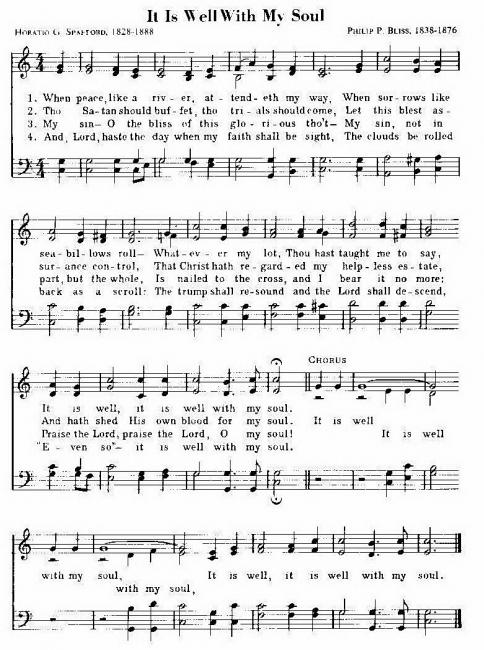Traditional Christian Hymns
It Is Well With My Soul
IT IS WELL WITH MY SOUL
Author: Horatio G. Spafford, 1828-1888
Music: Philip P. Bliss, 1838-1876
“God is our refuge and strength, a very present help in trouble.” Psalm 46:1
This beloved hymn was written by a Presbyterian layman from Chicago named Horatio G. Spafford who born in North Troy, New York, on October 20,1828. As a young man Spafford had established a successful legal practice in Chicago. Along with his financial success, he always maintained a keen interest in Christian activities. He enjoyed a close and active relationship with D. L. Moody and other evangelical leaders of that era. He was described by George Stebbins, a noted gospel musician, as a "man of unusual intelligence and refinement, deeply spiritual, and a devoted student of the Scriptures."
Some months prior to the Chicago Fire of 1871, Spafford had invested heavily in real estate on the shore of Lake Michigan, and his holdings were wiped out by this disaster. Desiring a rest for his wife and four daughters as well as wishing to assist Moody and Sankey in one of their campaigns in Great Britain, Spafford planned a European trip for his family in November of 1873. Due to unexpected last minute business developments, he had to remain in Chicago, but he sent his wife and four daughters on ahead as scheduled on the S.S. Ville du Havre. He expected to follow in a few days. On November 22 the ship was struck by the Locheam, an English vessel, and sank in twelve minutes. Several days later the survivors were finally landed at Cardiff, Wales, and Mrs. Spafford cabled her husband, "Saved alone." Shortly afterward Spafford left by ship to join his bereaved wife. It is thought that on the sea near the area where his four daughters had drowned, Spafford penned this text whose words so significantly describe his own personal grief—"When sorrows like sea billows roll..." It is noteworthy, however, that Spafford's hymn does not dwell on the theme of life's sorrows and trials but focuses attention in the third stanza on the redemptive work of Christ and in the fourth stanza anticipates His glorious Second Coming. Humanly speaking, it is amazing that one could experience such personal tragedies and sorrows as Horatio Spafford did and still be able to say with such convincing clarity, "It is well with my soul."
In 1881 the Spafford's fulfilled a life-long interest in the Holy Land. They left Chicago with their two young daughters and a group of friends and settled in Jerusalem. There they established the American Colony which cared for the sick and destitute. Although Horatio died just eight years later at the age of sixty, this significant ministry continued. The story of this special family and their ministry is told in the book. Our Jerusalem, written by the Spafford's daughter. Bertha Spafford Vesper.
Philip P. Bliss was so impressed with the experience and expression of Spafford's text that he shortly wrote the music for it, first published in one of the Sankey-Bliss Hymnals, Gospel Hymns No. Two, in 1876. Bliss was a prolific writer of gospel songs throughout his brief lifetime. In most cases he wrote both the words and music for his hymns. His songs, like most early gospel hymnody, are strong in emotional appeal with tunes that are easily learned and sung (see page 133).
Other hymns by Philip P. Bliss include "Hold the Fort" (No. 30), "I Gave My Life for Thee" (No. 34). "Jesus Loves Even Me" (No. 46), "Let the Lower Lights Be Burning" (101 More Hymn Stories, No. 55), and "Once for All" (ibid., No. 72).

Taken from 101 Hymn Stories © Copyright 1982 by Kenneth W. Osbeck. Published by Kregel Publications, Grand Rapids, MI. Used by permission of the publisher. All rights reserved.
Return To Traditional Christian Hymns
Return to Praise and Worship Home Page
Enjoy this page? Please pay it forward. Here's how...
Would you prefer to share this page with others by linking to it?
- Click on the HTML link code below.
- Copy and paste it, adding a note of your own, into your blog, a Web page, forums, a blog comment,
your Facebook account, or anywhere that someone would find this page valuable.